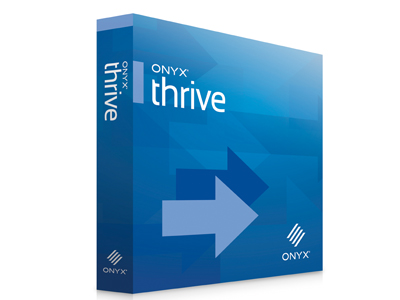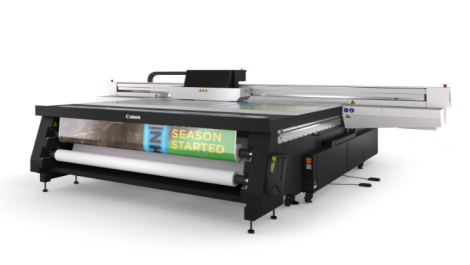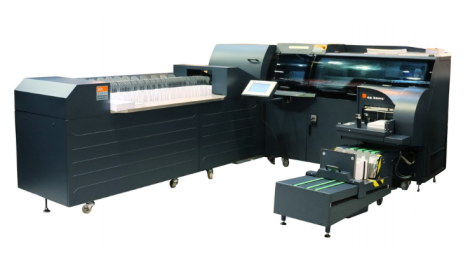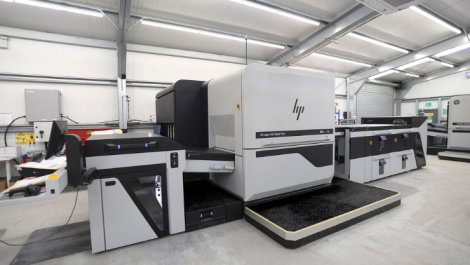EFI’s ‘all under one roof’ solution is built around its Pace MIS system
As competition increases in wide format print workflow is becoming an important tool to improve efficiency, finds Michael Walker.
‘Wide format’ is a catch-all term, covering applications from posters to free-standing point-of-sale displays, signage to vehicle wrapping, decals to banners and building wraps. And the machines that produce them, while they all image onto large pieces of media via inkjet print heads, also embody a range of technologies: roll-fed or flatbed (or hybrid), moving heads or moving tables, solvent-, eco-solvent, UV-cured or latex inks. And that’s without considering the enormous range of media that they print on, from paper to glass, vinyl to metal, back-lit film to wood.
So it is not surprising that ‘workflow’ can mean a lot of different things here too. While the idea of workflow has been well established in smaller format commercial and digital print, it is still less well understood and applied in the wide format sector, despite the availability of dedicated workflow solutions from a number of vendors for several years.
Workflow is at its core about managing jobs through production, from file receipt and pre-flighting through printing and finishing, aiming to ensure efficient use of printers, media, ink and operators. It’s tied in with automation and the idea of reducing the number of manual touches that any job is subject to, both to reduce the possibility for error and to optimise throughput while minimising costs.
Growing pains
The wide format sector has shown consistent growth over recent years, better than in many other parts of the print industry, but increasing adoption of these machines by printers from outside the conventional sign and display market can only drive up competition and put pressure on prices. For them and for existing players, investing in productivity is one way to enable margins to be maintained.
Part of the confusion around the term ‘workflow’ in wide format is perhaps down to where it’s implemented. Most RIP software now includes workflow capabilities such as colour management, nesting or tiling options to optimise use of media or create outsize products respectively. These capabilities may extend into artwork creation or editing too, as in the case of SAi’s FlexiSign and FlexiPrint software which combines vector and raster (bitmap) art editing with RIP functionality, as well as support for cutting. Another product at the ‘RIP-plus’ level is Rolandprintstudio, a Mac RIP that offers workflow type facilities such as template-based production, output configuration pre-sets and hot folder-based job scheduling and triggering. It can also generate application diagrams for vehicle wrap fitting and assign non-standard colour such as white or clear inks based on CMYK values without requiring special spot colour setup.
Fit to finish
Other capabilities that may be included with RIP software include artwork preparation for specific applications. This could be positioning of grommets or other fixings, hems and pockets for banner media attachment or cut and fold marks for corrugated or other rigid media used in self-supporting PoS displays, for example.
Pre-flighting is another essential. In wide-format this may extend beyond the usual missing fonts, placed graphics and wrongly defined colours to include warning about image resolution being insufficient for the output size and viewing distance. This may be supported by some kind of soft-proofing capability to check the content and that any finishing-related elements are present and correct. If nesting is supported, it’s useful to be able to preview this too, especially where ‘true-shape’ nesting that can rotate items and read cutting paths to achieve the most economical use of media is used.
Integration with external cutting equipment is often desirable too. This might be done by including drivers for specific cutting tables or possibly via JDF, which is starting to gain some traction in the wide-format arena.
Colour-accurate soft-proofing via calibrated display isn’t widely supported in wide-format, as the prevalence of brand colours and the enormous variety of substrates makes it very difficult to achieve, but some RIPs offer the ability to preview the rasterised image before committing to print. Colour management for the print itself is pretty well ubiquitous, however, and many systems allow the user to generate their own profiles for specific ink and media combinations to complement the standard sets supplied by printer manufacturers.

Dedicated workflow software Thrive from Onyx has been selling into medium and large print companies
Managing many printers
The capabilities discussed so far apply in single printer environments, which is why they are typically bundled with or part of the RIP software rather than sold as separate ‘workflow’ offerings. But as soon as you have two or more printers, job scheduling and production management become useful things to have. More than just a job queue that can be manually adjusted to suit changing priorities, features at this level allow jobs destined for a specific substrate to be ganged over time to optimise use of media, or to achieve load balancing across multiple machines, where the substrate and colour matching capabilities permit.
Another facet of job scheduling is looking beyond the print queue and towards finishing and dispatch. The bottleneck in large installations with high speed printers is often not in production but in getting work finished, sorted and packed for shipping; running the printers flat-out doesn’t help if the material is piling up at the next stage.
The ability to consider the bigger throughput picture is something that arrives with dedicated workflow solutions that sit above the RIP level, scheduling, preparing and sending jobs to the RIP for output, and also crosses over into MIS territory. Linking production workflow into an MIS makes possible live job status tracking, inventory control, measurement of consumables usage and how operator time is spent, which enables analysis of job profitability and helps to identify areas where money may be being lost.
At the other end of the production cycle, integration with web-to-print (W2P) portals is another way to reduce touch points as jobs are brought in or created online. Automation is perhaps even more important here, especially for anyone planning to offer consumer print services, where competitive pricing can mean that just about any unexpected manual intervention is enough to lose money on a job. For many, the implementation of a W2P portal makes more sense in the context of providing added convenience for existing business customers.
Joining the dots
The more complex systems come with price tags that put them beyond the reach of small sign shops, and this is reflected in the fact that dedicated workflow software like Thrive from Onyx Graphics has been selling best into medium and large print companies. Last year Onyx added Connect, an open-source module that supports JDF/XML communications with other systems so that jobs can be controlled externally and job and usage data collected by the MIS. At Fespa in March, Onyx expanded on this with the introduction of its Switch Configurator, which brings wide-format specific capabilities to Enfocus’s Switch workflow automation software.
Caldera already had something similar in Nexio, a workflow connection technology introduced a year earlier, which also supports Enfocus Switch and allows a variety of applications including W2P, accounting and MIS to be hooked up to the Flow+ workflow or to individual Caldera RIPs. This has been demonstrated running with Fujifilm’s XMF workflow, with the two communicating via JDF.
Agfa’s Asanti dedicated wide-format workflow also supports JDF communication and can increasingly drive printers other than the company’s own, as well as integrating tightly with the Asanti Storefront W2P offering.
A single source solution
EFI offers an ‘all under one roof’ solution in the guise of its Midmarket Productivity Suite which has just been upgraded to version 4, announced at Sign Expo in Florida in late April. Built around the company’s Pace MIS, but also including W2P, cross-media, estimating, scheduling, accounting and fulfilment capabilities among others, the new release includes features specifically aimed at display graphics and superwide-format printers.
The new capabilities address fleet and vehicle wraps, point of sale signage and outdoor graphics and include a request-for-quote dashboard, data tags for managing specific signage types and applications and a multiple object import tool to simplify campaign management tasks involving repeating orders that may vary in size and content. As with its other Productivity Suites, EFI guarantees compatibility between all components.
While EFI’s offering is very much a top-end solution, there is a spectrum of workflow-enhancing options right across the scale, from the one-printer sign shop to the biggest of providers with multiple sites and printer fleets. The common factor across the disparate companies, printer types, customers and applications is the ability to save time, reduce errors and improve profitability.
Three into one does go for Artistic Sign
Artistic Sign in Draper, Utah, USA runs a fleet of HP Latex machines and provides a lot of vehicle wraps and decals for emergency services and private fleet vehicles as far afield as Alaska and Florida. The firm has adopted SAi’s FlexiSign and FlexiPrint software to simplify its production process at several stages of the workflow from file prep through printing to finishing.
‘The one piece of software does the work of three – design, RIP and print,’ says owner Russ Scroggin. ‘Every time you export and import files you’ve got an opportunity for error, accidentally changing the colour, for example.’
Mr Scroggin also cites a number of ‘one-click’ tools included in the software, which simplify common effects such as the creation of drop-shadows, again speeding artwork creation.





